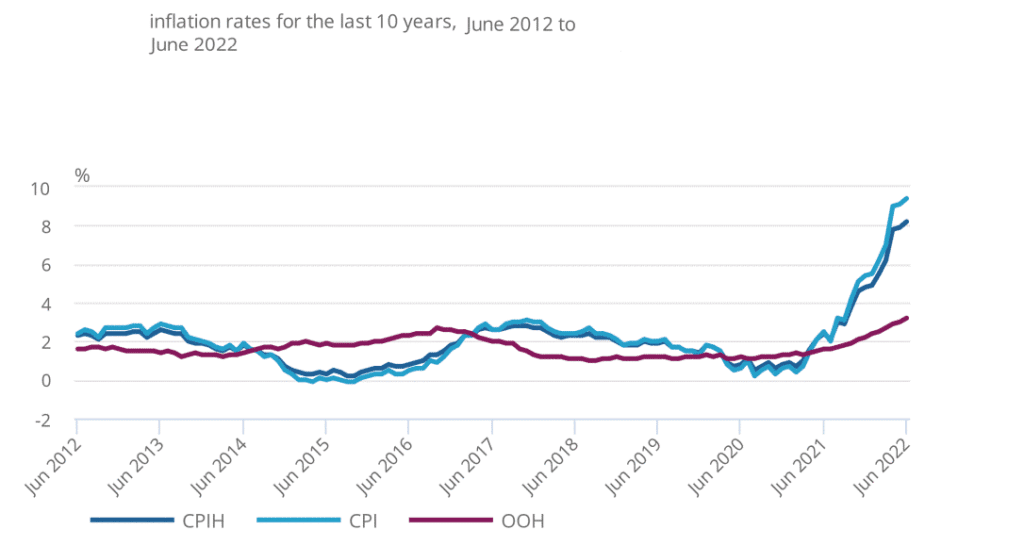What is US inflation data today
Despite a drop in petrol prices, US inflation showed little signs of cooling off in August due to rising prices for shelter, food and medical care. Food prices increased 11.4% from a year earlier. In August, the three-year average US inflation rate stood at 4.9%, far beyond the 2% goal.
Investors were hoping that the US inflation data would show some encouraging signs that prices of goods and services have decreased. Instead, the opposite happened in September.
Three measures of inflation.

The most commonly used inflation indexes are the Consumer Price Index and the Wholesale Price Index. The three measures of inflation (i.e., CPI m/m, CPI y/y, and Core CPI m/m) have exceeded the market expectations. In other words, inflation is not cooling down, and this is a worry for risky assets.
US inflation shows that the prices of goods and services continue to rise, affecting the US consumer
- sonic inflation
Demand-pull inflation exists when aggregate demand for a good or service outstrips aggregate supply. It starts with an increase in consumer demand. Sellers meet such an increase with more supply. But when additional supply is unavailable, sellers raise their prices.
2.Cost-push inflation
Cost-push inflation occurs when the aggregate supply of goods and services decreases because of an increase in production costs. For instance, if low-paid workers in a factory form a union and demand higher wages, it’s possible the factory owner will simply shut down the business in response.
3.Built-in inflation
Built-in inflation can be viewed as a double-edged sword. As laborers demand higher pay, the cost of production increases, which can raise the cost of living. When the cost of living increases, laborers might begin to demand higher pay. Each factor influences the other, resulting in a cycle
Must Read : How stocks & prices are effected by inflation cultre
How to Protect Your Money from Inflation
When inflation is rising at a rate higher than normal, here are steps you can take to protect the purchasing power of your dollars.
- Trim your expenses. To minimize the impact of inflation, review your spending and identify areas to reduce or eliminate completely. It will free up money to invest so you can be better prepared for the future.
- Wait to pay off low-interest debt. Paying off debt is usually good, but you may want to hold off on making extra payments if you have low-interest debt. Your debt becomes less expensive due to inflation. The extra money may be better used for other purposes—like paying off higher-interest loans.
- Invest your money. Inflation causes your savings to be worth less over time. To hedge against inflation, you need to invest your money in the stock market. If the prospect of investing is scary, consider a diversified portfolio of index funds to lower your risk levels.
The brief period of extravagant spending
Despite rising prices, many consumers have been continuing to spend. In May 2022, personal consumption expenditures (which account for inflation) were up 0.5% compared to the month prior, according to the Bureau of Economic Analysis.
Rather than adjust their spending habits, Americans have been relying on their savings to cope with price hikes. A recent survey of over 2,000 Americans showed that 67% of respondents have used some of their savings to deal with price increases, and 23% have made a substantial dent in their nest eggs.
To help combat inflation, central banks have been raising interest rates to encourage savings and ultimately slow down spending. But this is a delicate dance—if rates are raised too fast and spending screeches to a halt, this could lead to a recession.
FAQ – US inflation data today (Must Read)
What is inflation?
Inflation is the rate of increase in prices over a given period of time. Inflation is typically a broad measure, such as the overall increase in prices or the increase in the cost of living in a country.(US inflation data today)
Types of inflation
demand-pull inflation
cost-push inflation
Built in inflation(US inflation data today)
What is demand-pull inflation ?
Demand-pull inflation exists when aggregate demand for a good or service outstrips aggregate supply. It starts with an increase in consumer demand. Sellers meet such an increase with more supply. But when additional supply is unavailable, sellers raise their prices(US inflation data today)
What is cost-push inflation ?
Cost-push inflation occurs when the aggregate supply of goods and services decreases because of an increase in production costs. For instance, if low-paid workers in a factory form a union and demand higher wages, it’s possible the factory owner will simply shut down the business in response.
What is Built in inflation ?
When there is increase in the prices of goods and services the involved labour also expects and demands more costs/wages to maintain their cost of living. This spirals to further increase in the prices of goods leading to inflation.
Is inflation good or bad ?
While high inflation can be harmful, too little inflation can also weaken the economy. When the economy is struggling and inflation is too low, the Fed will take the opposite approach by lowering interest rates or buying assets to increase cash circulation.
When Is Inflation a Good Thing?
The Federal Reserve has two jobs: maximize employment and maintain price stability. The Federal Open Market Committee (FOMC) judges that an inflation rate of 2% helps achieve those mandates.
This amount of inflation allows households and businesses to make financially sound decisions on saving, investing and borrowing money
Who Benefits from Inflation?
Homeowners Benefit from Inflation
People with Fixed-Rate Debt Benefit from Inflation
Investors May Benefit from Inflation
Ashish Dwivedi is the founder and chief editor of MoneyMystica, a top resource for finance, insurance, and share market insights. Driven by a passion for empowering individuals to make informed financial decisions, Ashish uses his extensive knowledge and practical experience to offer clear and actionable advice.


